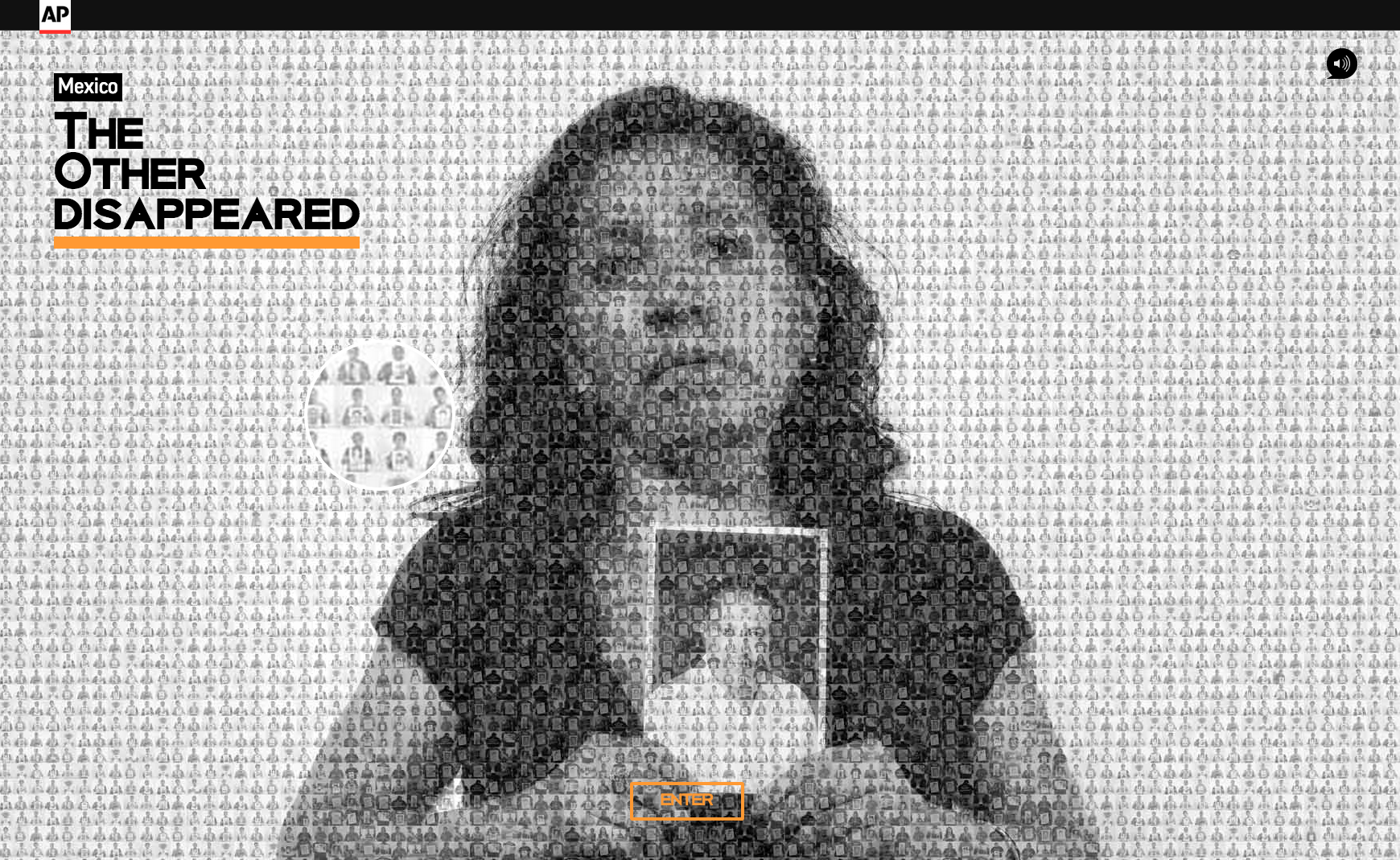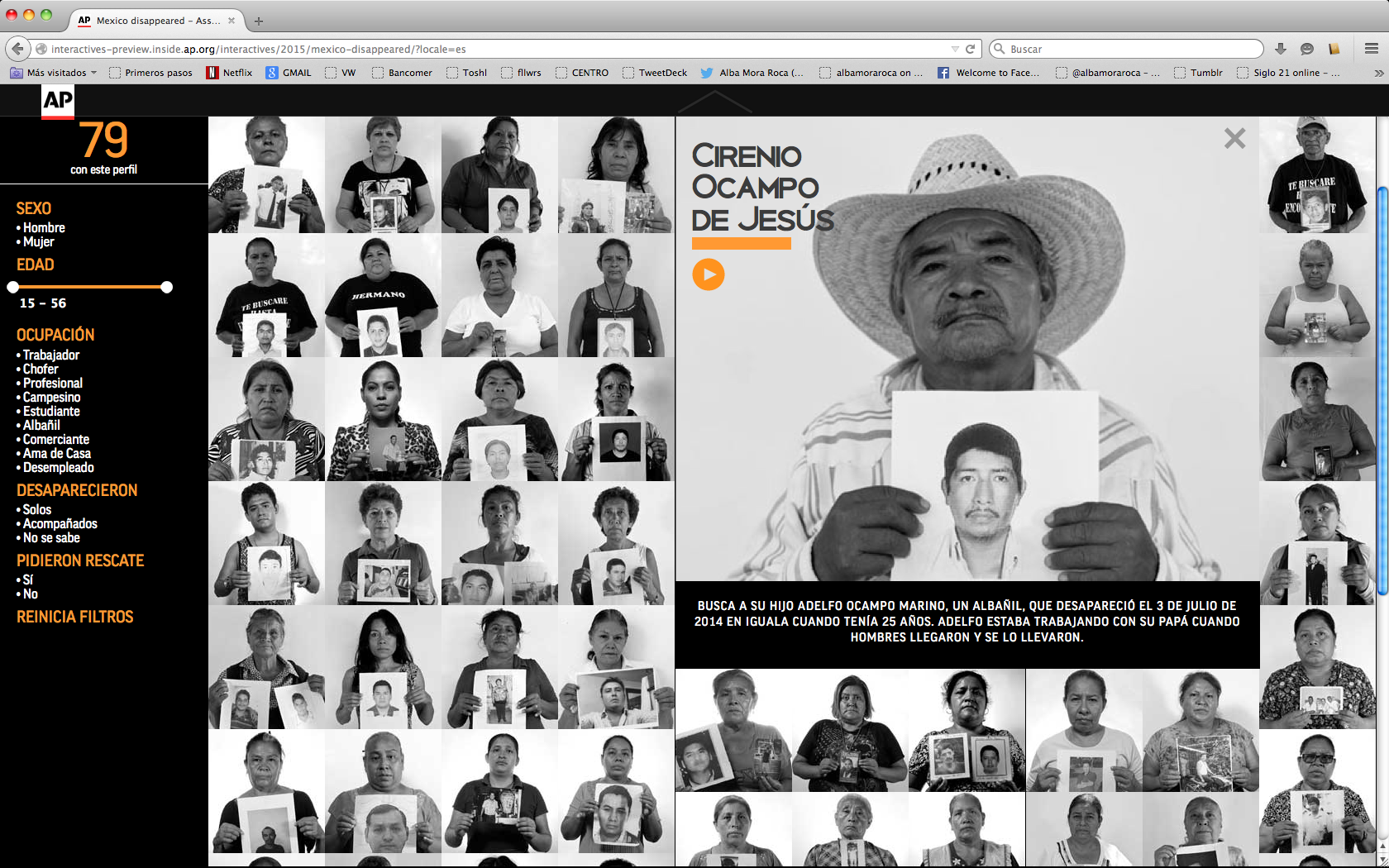Ayotzinapa is a piece
of bigger, massive tragedy
The following video is just a teaser .
For the full experience, please click the link below.
SYNOPSIS/
The disappearance of 43 students from a Mexican teachers college last year caused international outrage. The government’s official conclusion: The youths had been killed and the ashes of their incinerated bodies dumped in violent Guerrero state.
The Associated Press wanted to look behind the headlines in the case and at the wave of kidnappings and murders that have gripped Mexico.
The number itself is shocking: More than 25,000 people have vanished throughout the country since 2007. Victims’ individual stories and images, gathered over six months as AP interviewed more than 150 grieving families in Guerrero, show the toll in a new and unflinching way.
MOCK UPS/
REPORTERS PROMO/
MY ROLE/
I worked as the lead multimedia producer, bringing the project from start to finish. I was responsible for the overall creative direction of the interactive, working with and managing a team of photographers, reporters, editors and developers involved with the project. My focus was to create an original interactive that translated all the existing materials into something cinematic and moving.
Here’s a list of some of my responsibilities:
- Develop the concept behind the project, and decide what forms of media will be used and how.
- Organize all the pre existing raw materials and formats (150+ interviews and portraits).
- Direct, edit and produce the video. I had the creative control over the shooting, screenplay and editing. That includes everything from sound design to post production and exports in various formats.
- Coordinate follow up and feedback sessions with reporters, photographers and other team members at the AP.
- Design the visual layout and the look of the interactive across all platforms (mobile, tablet and desktop).
- Worked closely with AP developer Roque Ruiz for the coding of the interactive, to make sure that works seamlessly with the AP backend system.
- Listen, clean and edit the most remarkable interviews, videos and photos among the hundreds of audio clips and photo portraits.
- Test and execute the interactive in several browsers and devices to find bugs, improve performance and make sure that responds correctly in different environments.
- Work together with AP reporters to fact check and copy edit the project for both Spanish and English.
- Produce shareable images, videos, GIFS and tweets to promote the interactive through social media.
BEHIND THE SCENES/
Going into the reporting, AP knew this story would take time because of the goal of interviewing and photographing as many survivors as possible and the need to win their confidence. Sherman, a Mexico City newsman, made at least 13 trips to Iguala, a 2¼ hour-drive from Mexico City. Acting bureau chief Castillo and photo editor Dario Lopez visited almost as often.
Safety was a concern. The area is dominated by the Guerrero Unidos drug cartel and corrupt officials who are in their pocket. The AP interviewed most family members at a church where they’d gather to coordinate the search for their loved ones. Others were interviewed in their homes.
From the start, the AP team told the families it envisioned this project as an interactive because of the number of individual stories that would be included. The families voted to back the effort, thoughsome declined to be photographed or would allow only photos from the neck down holding pictures of loved ones. Many who were initially wary changed their minds when they realized this would be an in-depth report and it was a chance, finally, to tell their stories.
Chris Sherman and Dario Lopez visited Iguala after the interactive got published week to show family members the finished product, fulfilling a promise they’d made during the reporting.
It was Dario Lopez’s idea to do portraits of families holding photos. Sherman and Castillo recorded hundreds of hours of audio of families telling their stories (which can be heard on the last page of the interactive).
The arresting photos and video shot by Dario Lopez and video journalist Ricardo Lopez, along with poignant audio testimonies of survivors, make the interactive one of the most powerful the AP has ever produced.
CREDITS/
Video Alba Mora Roca, Ricardo Lopez
Photos Dario Lopez Mills
Interactive Roque Ruiz, Alba Mora
Reporting Chris Sherman, Eduardo Castillo
Music Joan Bramon
Published September 15th, 2015
TWITTER REACTIONS/


